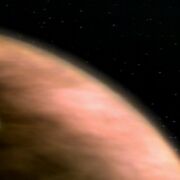m (hyperlink ru) |
m (lk fix) |
||
| (2 intermediate revisions by 2 users not shown) | |||
| Line 1: | Line 1: | ||
[[File:Tau Cygna V.jpg|thumb|The class H-planet [[Tau Cygna V]]]] |
[[File:Tau Cygna V.jpg|thumb|The class H-planet [[Tau Cygna V]]]] |
||
| − | In the [[Federation]] standard system of [[planetary classification]], a '''class H''' [[planet]] was characterized as usually being uninhabitable by [[Human]]s. In the [[Treaty of Armens]], "unwanted lifeforms inhabiting H |
+ | In the [[Federation]] standard system of [[planetary classification]], a '''class H''' [[planet]] was characterized as usually being uninhabitable by [[Human]]s. In the [[Treaty of Armens]], "unwanted lifeforms inhabiting H-class worlds may be removed at the discretion of the [[Sheliak Corporate]]." ({{TNG|The Ensigns of Command}}) |
| − | An H |
+ | An H-class planet or [[moon]] could contain an atmosphere consisting of [[oxygen]] and [[argon]]. ({{VOY|Scorpion, Part II}}) |
| + | ===Example=== |
||
| − | Examples of a Class H planets: |
||
* [[Tau Cygna V]] |
* [[Tau Cygna V]] |
||
| + | |||
| ⚫ | {{bginfo|According to the ''[[Star Trek: Star Charts]]'', on page 24, class H worlds had an age of four to ten billion years and had a diameter ranging from 8,000 to 15,000 kilometers. They were found throughout [[star system]]s. These desert planets were categorized by a hot and arid surface, with little or no surface [[water]] and an [[atmosphere]] that might contain heavy [[gas]]ses and [[metal]] vapors. [[Lifeform]]s found on class H planets included drought- and [[radiation]]-resistant plant life and similar animal life.|Because they are also arid planets, [[Ocampa (planet)|Ocampa]], [[Nimbus III]], [[Rigel XII]], and [[Ceti Alpha V]] (as of [[2268]]) could also be H-class planets, but they were never identified as such.}} |
||
{{Planetary classification}} |
{{Planetary classification}} |
||
| − | |||
| − | == Appendices == |
||
| − | === Background information === |
||
| ⚫ | According to the ''[[Star Trek: Star Charts]]'', |
||
| − | |||
| − | Because they are also arid planets, [[Ocampa (planet)|Ocampa]], [[Nimbus III]], [[Rigel XII]] and [[Ceti Alpha V]] (as of [[2268]]) could also be H class planets, but they were never identified as such. |
||
[[de:Klasse H]] |
[[de:Klasse H]] |
||
Revision as of 12:19, 3 July 2013

The class H-planet Tau Cygna V
In the Federation standard system of planetary classification, a class H planet was characterized as usually being uninhabitable by Humans. In the Treaty of Armens, "unwanted lifeforms inhabiting H-class worlds may be removed at the discretion of the Sheliak Corporate." (TNG: "The Ensigns of Command")
An H-class planet or moon could contain an atmosphere consisting of oxygen and argon. (VOY: "Scorpion, Part II")
Example
According to the Star Trek: Star Charts, on page 24, class H worlds had an age of four to ten billion years and had a diameter ranging from 8,000 to 15,000 kilometers. They were found throughout star systems. These desert planets were categorized by a hot and arid surface, with little or no surface water and an atmosphere that might contain heavy gasses and metal vapors. Lifeforms found on class H planets included drought- and radiation-resistant plant life and similar animal life.
Because they are also arid planets, Ocampa, Nimbus III, Rigel XII, and Ceti Alpha V (as of 2268) could also be H-class planets, but they were never identified as such.
| Planetary classification |
|---|
| B • D • G • H • J • K • L • M • N • R • T • Y • Other classes |
